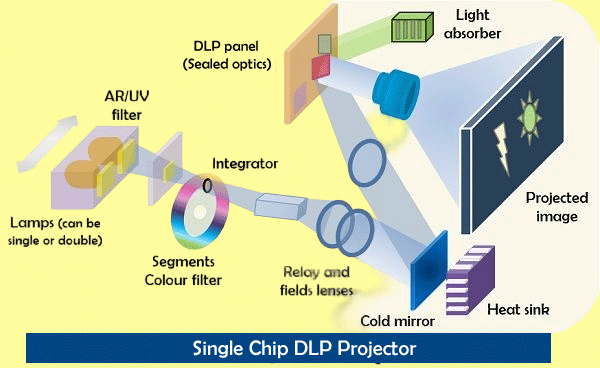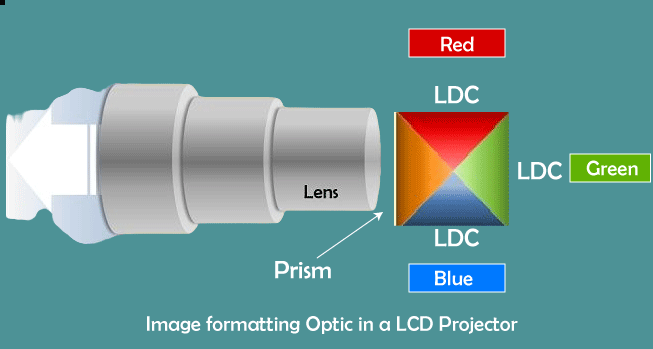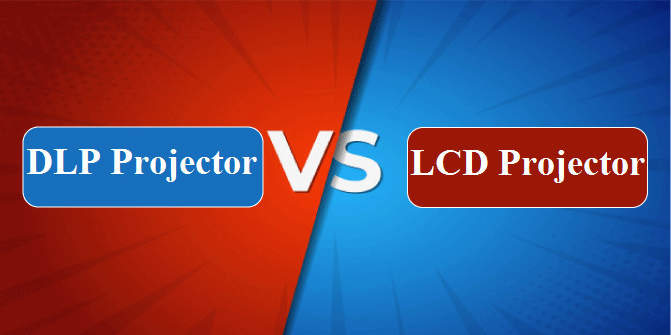Difference between DLP and LCD ProjectorA projector is a type of visual display unit that projects images and videos onto a screen. There are various types of projectors available depending on the technology utilized, such as LCD projectors, LED projectors, DLP projectors, 4K projectors, Laser projectors, etc. DLP and LCD are DVP (Digital Video Projection) technologies that are utilized to display the computer screen over a big wall and LCD screen. The main distinction between these projectors is that DLP projectors utilize a series of mirrors mounted on a microprocessor to serve as pixels. In contrast, LCD projectors utilize liquid crystals that are placed between two polarizing filters and two transparent electrodes. In this article, you will learn about the difference between DLP and LCD projectors. But before discussing the differences, you must know about DLP and LCD projectors with their advantages and disadvantages. What is DLP Projector?DLP is an abbreviation for "Digital Light Processing". It is a reflective projection technology that utilizes a Digital Micrometer Device (DMD) microchip to combine a microelectrochemical system (MEMS) and a projection display. The unusual microchip is comprised of a MEMS array of semiconductor-based digital light switches that precisely regulate a light source. The initial DLP projector was designed and introduced by Texas Instruments in 1987. The main component of a DLP projector is a DLP microchip with microscopic mirrors, a light source, a projection lens, a color filter, and a digital video graphic stream. The small mirrors are either pointed at or away from the light source to form an image on the screen. A pixel is produced on the screen by quickly tilting mirrors, and colors are included using a color wheel. DLP projectors are most commonly utilized in digital video projection. DLP projectors have a narrow viewing angle but are less expensive than LCD projectors. Image ProjectionThe DLP projector comprises digital light switches employed in the DMD chip and is as small as 16×16 μm mirrors (one mirror for each pixel). Each mirror is movable and may be flipped between two angles. The first angle reflects the light in the projection aperture, resulting in a brilliant pixel. The other angle reflects light away from the projection aperture and creates a dark pixel over the screen. The greyscale is shown by rapidly flipping the mirror between the two angles millions of times in a second. 
The typical DLP includes black and white chips, but if the user desires to create color images, one of the two approaches may be used single-chip or three-chip. These single-chip and three-chip approaches require distinct components. The single chip employs a single DLP and places a rapidly spinning color wheel between the DMD chip and the lamp. However, with the three-chip technique, three different DMD chips are inserted for each main color, which forms an image by converging it. How do DLP Projectors Work?DLP projectors with a single matrix semiconductor chip may generate over 16 million colors. On the other hand, 3-chip models may generate 35 trillion colors. The mirrors may be moved swiftly to reflect light through the lens or right into a heat sink or a "light dump". However, the near proximity of each mirror within a chip makes it difficult to see any gaps between the pixels. When compared to the technology utilized in LCD projectors, this results in a more crisp and fluid image. Advantages and Disadvantages of DLP ProjectorsThere are various advantages and disadvantages of DLP Projectors. Some advantages and disadvantages of DLP projectors are as follows: Advantages
Disadvantages
What is LCD Projector?LCD is an abbreviation for a "Liquid Crystal Display". LCD projectors are built with tiny liquid-crystal displays that transmit light rather than reflect it. Three panels represent each color. However, a fourth panel can be employed to improve color generation. The optical filters' principal function is to split the white light from the lamp into three colors (RGB) and direct them via their appropriate panels. The liquid crystals in an LCD projector are placed between two polarizing filters and two clear electrodes. The liquid crystals function as pixels when an electric source is attached to electrodes. These liquid crystals either enable the light to travel through or be blocked. It should be noted that liquid crystals don't emit their own light. As a result, in the case of LCD projectors, an external light source is necessary. Image FormationThe LCD projector creates an image by rapidly transmitting different electrical signals to every pixel. It may generate the two most probable outcomes. In the first case, the light is passed via the LCD panel, resulting in a bright pixel on the screen. 
In the second case, the light is absorbed by the panel, resulting in a dark pixel on the screen. The projected image should be positioned in the same location across the screen, which is ensured by enclosing a prism in red, green, and blue (RGB) panels. How does an LCD Projector work?The polarized mirrors on the LCD projector block certain hues of light while allowing other colors to pass to reproduce whatever image it desires to display digitally. It works on the same principles as a cathode-ray tube to produce images on its glass screen. Each channel of red, green, and blue (RGB) is divided and converged by a prism after passing via the namesake LCD panel, which controls the saturation and intensity of every color for each video frame or video game displayed. Advantages and Disadvantages of LCD ProjectorsThere are various advantages and disadvantages of LCD Projectors. Some advantages and disadvantages of LCD projectors are as follows: Advantages
Disadvantages
Key differences between DLP and LCD Projector
There are various key differences between DLP and LCD Projector. Some of the key differences between the DLP and LCD Projector are as follows:
Head-to-head comparison between DLP and LCD ProjectorHere, you will learn the head-to-head comparisons between the DLP and LCD Projectors. The main differences between the DLP and LCD Projector are as follows:
ConclusionBoth LCD and DLP projectors have advantages and disadvantages, with the DLP projector being more appropriate when the user's goal is to show data with a low-cost investment. In contrast, the LCD projector is more suited for exhibiting flawless color reproduction during video playback.
Next TopicDifference between
|
 For Videos Join Our Youtube Channel: Join Now
For Videos Join Our Youtube Channel: Join Now
Feedback
- Send your Feedback to [email protected]
Help Others, Please Share










